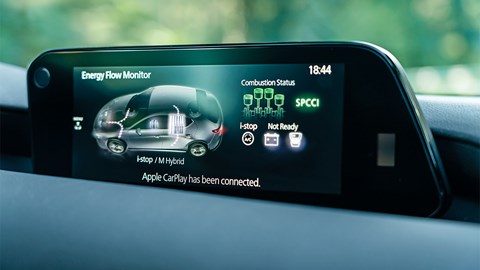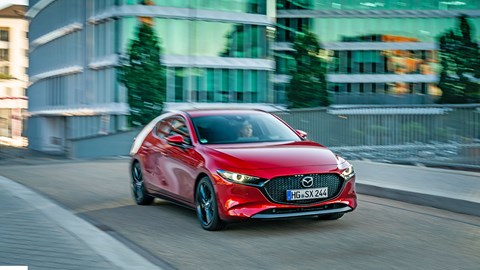► Mazda’s Skyactiv-X engine
► Petrol-powered compression ignition
► Available from 2019
Free-revving and fun like a petrol engine but with the torque, economy and CO2 emissions of a diesel – that’s the boiled down, highly concentrated jusof Mazda’s clever new engine technology. The engine has been in development since 2013, but we’ve finally driven it in the production version of the new Mazda 3 hatchback.
Skyactiv-X uses diesel-esque ‘spark controlled compression ignition’ (SPCCI). A unique piston design, a fuel injection system capable of super-high pressures and an air compressor that forces air into the fuel all work together to create a fuel-to-air ratio two to three times leaner than that of a regular petrol engine – so much so that a regular spark plug can’t always ignite it. The mixture is split into two zones when compression ignition is active; the lean mix first floods the combustion chamber, then a second, richer amount of atomised fuel is fired at the spark plug to ignite the whole mix on compression.

SPCCI only works under part load, the idea being that Mazdas equipped with this engine should offer better fuel economy and lower emissions in town. The spark plug controls the combustion at higher loads, just like a normal petrol engine, so Mazda claims knocking and a wobbly combustion cycle is avoided when the switch is made.
A handy graphic in the 3’s energy monitor, with an icon shaped like four pistons glowing green, shows when SPCCI is active. Mazda claims up to 20 per cent better fuel economy compared with its regular Skyactiv-G petrol engine.
Mazda also changed the gear ratios with the X, making first, second and sixth long but splitting third, fourth and fifth by a few hundred revs, changing your attitude to that slick manual ’box. The engine needs to be worked, but differently.
In practice? It’s not as revolutionary as Mazda would have you believe. There’s just 8lb ft extra torque, available at 3000rpm (instead of 4000rpm like the G), which isn’t exactly game-changing; the engine still feels breathless getting up to motorway speeds, despite a healthy 178bhp.

During our time with the X, we managed 43.5mpg – around 5mpg down on the claimed figure. Still, the engine now means there are Mazda hatches that drop below the 100g/km CO2 barrier without a turbo, which will please fleet buyers looking for style and low running costs.
So, does it work?
Not really. It’s a genuine innovation but the improvements on CO2 and torque between this and the weak (conventional) Skyactiv-G engine are marginal. Still, we shouldn’t discount it; the tech is there to stretch out the life of the non-turbo internal combustion engine.